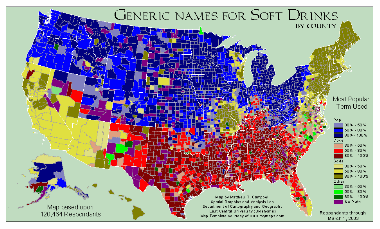Thursday, September 30, 2010
Wednesday, September 29, 2010
Awwwww, Isn’t He (She) Cute?
Shortly after I got out of the Army – late 1968 or early ‘69 – we lived in an apartment on Ocean Drive in Corpus Christi, Texas. One of our neighbors told another couple who lived there that their new-born baby looked like “A Red, Drowned, and Bastard Rat.” The two couples had been best friends before Bob (not me, the other Bob in the complex) made his pronouncement, but I don’t think they ever spoke again.
Oddly enough, although what Bob said was his true opinion, and not that far off the mark; if he had just waited another hour or so to see his friend’s little nipper, the chances are he would never have said or even thought anything like that.
Once they are cleaned up and their blood pressure and respiration normalizes, healthy babies are pretty generic and have a universal appeal.
Nigerian babies are a little darker than Swedes, and Mexicans are typically born with more hair, but they all still look pretty much alike. Their faces are all broader, their eyes larger and their noses smaller than their adult counterparts. Nature has designed them to be at their most attractive, and evolution has determined that our reaction to them will be warm, fuzzy and protective. It’s all part of how we are programmed in order to maintain the species.
This baby-love thing is so well programmed in us that it carries over to puppies, kittens and fawns. We even look at babies that will end up huge, like elephants and hippos, or dangerous as lions, tigers and bears and think they’re adorable. We just can’t help it.
Newborns don’t really have their mommy’s eyes, or uncle Willie’s nose, but the fact that they are these generic little blank slates allows us to think so. If you really think about it, a week-old child with Willie’s nose or Grandpa’s ears would look silly as Hell. His mother would probably still love him, but the neighbors would probably think he looked weird.
Nobody should ask old Bob what he thinks of the kid; he just might tell you the truth.
Tuesday, September 28, 2010
A True Wonder-Bra
At last year’s igNoble awards, one of the winners was a brassiere that converted into a pair of gas masks in case of a chemical or biological attack. I, like most folks, had a laugh at the inventor’s expense and promptly forgot about it.
Well, the laugh may be on me. The bras are for sale; $29.99 each at ebbra.com. They come in bright red, and in sizes from 32B to 40C. I guess that more generously endowed women are out of luck – or maybe not; the company has a press conference scheduled for this morning where it is rumored that they will introduce a similar life-saving device designed for men.
Emergency Bra press conference today
September 28th, 2010
Dr. Elena Bodnar will hold a press conference today, Tuesday, Sept 28, at 11:00 am — at the MIT Museum to announce that her Ig Nobel Prize-winningEmergency Bra is now available to the public, and to present a new invention (a counterpart device to be worn by men).
You are invited to attend.
(For a bit more background info, including videos, see the blog post here.)
BONUS: A report in today’s Sydney Morning Herald, with good educational video from the Associated Press
Monday, September 27, 2010
Stink Bugs and Politicians
I saw multiple posts over the weekend on RV.Net about the stink bugs that are taking over campgrounds in the Del-Mar-Va.
The bug in question is the Brown Marmorated Stink Bug (pictured above) a new arrival from the Orient. The first of the critters was reported in Allentown, Pennsylvania, in 1998 and they have now been found in 29 states. They don’t bite, they don’t sting, but they do smell awful if crushed.
While researching the little pest, I came across the following editorial. I have a feeling the author may be confusing Republicans with Libertarians, but he does have a point:
September 26, 2010
IT'S NOT JUST THE BUGS THAT STINK.... The Washington Post ran an item the other day that, at first blush, doesn't seem especially political, but is worth considering in a larger context.
The issue is the spread of the brown marmorated stink bug through the mid-Atlantic states. They're harmless to people -- the don't bite, sting, or carry diseases -- but for the first time in on the continent, they're doing significant damage to crops, ornamental shrubs, and trees. And as homeowners are discovering, as the bugs begin moving inside as temperatures drop, "when squashed or irritated, the bugs release the distinctive smell of sweaty feet."
The insects reached the U.S. in Allentown, Pa., apparently as stowaways in a shipping container from Asia. Now they're spreading, they have no known natural predators, and there's "no easy way to kill lots of the bugs at once." Complicating matters, "the invasion is only going to get worse."
So, where's the political angle?
Rep. Roscoe Bartlett, a Republican who represents Maryland's rural 6th District, sent a letter Friday, signed by 15 members of Congress, asking U.S. Agriculture Secretary Tom Vilsack and Environmental Protection Agency Administrator Lisa P. Jackson to take immediate action to limit damage caused by Halyomorpha halys.
Of the 15 members who signed the letter, eight of them are Republicans -- all from states between West Virginia and New Jersey, and all fairly conservative members of the GOP caucus. The group of lawmakers are looking for "coordinated federal government assistance" from the Obama administration to help farmers and local economies deal with the bugs.
In particular, the 15 lawmakers are eyeing a proposal to reclassify the species under federal guidelines to expand regulatory authority over the bugs.
In other words, faced with a environmental problem, the first instinct from conservative Republican politicians is to ask the federal government to do something. Indeed, they're specifically asking for federal bureaucrats to sweep into action and use expanded federal regulations to help people.
Hmm.
There seems to be a bit of disconnect here between Republican ideology and real-world problems. On the one hand, conservative lawmakers like Bartlett hate "big government," the EPA, federal regulations, and government bureaucrats. This year, plenty of GOP candidates are talking about eliminating the EPA, firing parts of the federal workforce, scrapping regulations, and slashing spending on various agencies.
Shouldn't conservative lawmakers, right about now, expect the free market to offer a solution to the stink-bug problem? Why hasn't the GOP offered everyone a tax credit for fly swatters and facemasks? Why aren't Tenthers running around demanding to know where, exactly, the Constitution empowers the federal government to deal with an insect infestation?
As it turns out, the EPA, USDA, and scientists at a variety of regional universities (remember, conservatives generally approve of neither scientists nor universities) are working on possible solutions. Hopefully, they'll be successful.
In the meantime, let this be a reminder to all of us -- the federal government can and does play a vital problem-solving role in American public life. Republicans know this, even when they pretend otherwise.
—Steve Benen 9:25 AM Permalink | Trackbacks |
The moral of this story is:
Our morals, beliefs, values are only valid if we hold on to them when they are inconvenient.
Oh- and marmorated means streaky, looks like marble.
Sunday, September 26, 2010
Where’s Laura
I know that I said I was not going to write any more about little girls in little boats out on the great big ocean here, but with the extremely active hurricane season spinning storm after storm off the African coast, I couldn’t help myself.
A check of Laura Dekker's website shows she is safe – enjoying the sights in Pasito Blanco, Canary Islands.
Incidentally, her projected path on the map shows trips through both the Panama and Suez canals, avoiding those dangerous Southern Passages around Cape Horn and the Cape of Good Hope.
Saturday, September 25, 2010
A Road To Avoid
Actually, it isn’t a road at all. It’s the photo of an estuary South of New Orleans. It was taken by a Plaquemine Parish employee to document a fish kill.
The brackish water of the estuary is normally the breeding ground for lots of fish, crabs, etc. but a blocked outlet, along with several days of high temperatures depleted the oxygen, causing thousands of fingerlings to die.
Friday, September 24, 2010
Dishwasher Not Working? Blame the Government!
Noticed that the dishes don’t seem to get as clean lately? Here’s why:
Excerpts from an article in the New York Times:
“My dishes were dirtier than before they were washed,” one angry consumer wrote last week in the review section of the Web site for the Cascade line of dishwasher detergents. “It was horrible, and I won’t buy it again.”
“This is the worst product ever made for use as a dishwashing detergent!” another consumer wrote.
Like every other major detergent for automatic dishwashers, Procter & Gamble’s Cascade line recently underwent a makeover. Responding to laws that went into effect in 17 states in July, the nation’s detergent makers reformulated their products to reduce what had been the crucial ingredient, phosphates, to just a trace.
While phosphates help prevent dishes from spotting in the wash cycle, they have long ended up in lakes and reservoirs, stimulating algae growth that deprives other plants and fish of oxygen.
Yet now, with the content reduced, many consumers are finding the new formulas as appealing as low-flow showers, underscoring the tradeoffs that people often face today in a more environmentally conscious marketplace. From hybrid cars to solar panels, environmentally friendly alternatives can cost more. They can be less convenient, like toting cloth sacks or canteens rather than plastic bags or bottled water. And they can prove less effective, like most of the new cleaning products.
Phosphorus in the form of phosphates suspends particles so they do not stick to dishes and softens water to allow suds to form.
Now that the content in dishwasher detergent has plummeted to 0.5 percent from as high as 8.7 percent, many consumers are just beginning to notice the change in the wash cycle as they run out of the old product.
“Low-phosphate dish detergents are a waste of my money,” said Thena Reynolds, a 55-year-old homemaker from Van Zandt County, Tex., who said she ran her dishwasher twice a day for a family of five. Now she has to do a quick wash of the dishes before she puts them in the dishwasher to make sure they come out clean, she said. “If I’m using more water and detergent, how is that saving anything?” Ms. Reynolds said. “There has to be a happy medium somewhere.”
Similarly, a nonprofit group in Oakland, Calif., that helps women form environmentally minded cooperatives and trains house cleaners, says their employers have often resisted switching to the new cleaning products.
“There’s the myth that to be clean it has to shine or smell or make a lot of bubbles,” said Ivette Melendez, one of the trainers for the group, Women’s Action to Gain Economic Security. She says products like vinegar, baking soda or the newer cleansers work just as well as traditional items if applied in the proper mix and quantities.
But Jessica Fischburg, a commerce manager in Norwich, Conn., for CleaningProductsWorld.com, which sells janitorial supplies in bulk, said she was not surprised that many of her clients rejected products marketed as environmentally friendly.
“The reality of any green product is that they generally don’t work as well,” she said. “Our customers really don’t like them.”
Thursday, September 23, 2010
Wednesday, September 22, 2010
Caribou Barbie
Ray Stevens has a new album ( do they even call them that anymore?) and it is more than a little political. Ray lets you know what he thinks on a variety of issues from A to A – Arizona to Afghanistan – and a whole lot more.
The collection called We the People is currently at number 10 on Billboard's Top Comedy Albums.
Most of the songs are available for download, or you can buy the CD/DVD from Ray Stevens.com
Tuesday, September 21, 2010
You Say Tomato, I say Coke
Demographers at East Central (Oklahoma) University prepared this map showing what soft drinks are commonly called, by county, across the USA.
I remember being in Muskogee, Oklahoma, as a child and having an aunt ask me if I wanted a pop. I thought she was about to hit me like the guy in the Hawaiian Punch ads.
Interesting map, but unlike the multi-ethnic folks in my Sunday post , soft drink consumers are forced to pick just one name. There is no color on the map for soda pop.
Monday, September 20, 2010
H0-Hum
Maggie Koerth-Baker writing in Boing-Boing.net
How contagious is yawning? Enough that I'm yawning right now just from writing about it. Admittedly, I'd never given it much thought, but I always kind of assumed that contagious yawning—that tendency to pick up a yawn from the people around you and pass it on like the evil videotape in The Ring—was something all humans were susceptible to.
But that seems to be over-generalizing a bit. Everybody spontaneously yawns. Even fetuses. And around 40-60% of us will yawn if someone else around us yawns. But that's neurotypical adults.
There's a growing collection of research showing that very young children, and people with autism spectrum disorders, don't succumb to contagious yawning. In fact, contagious yawning is currently thought to be related to the development of empathy and the ability to distinguish our own mental states from those of others. One study, done in 2007, even found that psychology students—who presumably spend a lot more time than average thinking about other people's mental states—were more susceptible to contagious yawning than engineering students.
Oh, and yawning, in general? Yeah, nobody really knows why we do that.
Sunday, September 19, 2010
Minority Report
AUSTIN, Texas — From an official UT press release:
For the first time in the history of The University of Texas at Austin, fewer than half of the fall semester's first-time freshmen are white students, according to a preliminary analysis.
The report, provided by Kristi Fisher, associate vice provost and director of the Office of Information Management and Analysis, shows the number of first-time freshmen who identified their ethnicity/race as "white" on admissions information total 47.6 percent. The university's overall total white student population, including graduate, Pharmacy Doctorate and law students, is 52.1 percent.
The figures reflect changes in the demographics of Texas. The Office of the State Demographer, Texas State Data Center, estimates the state's ethnicity in 2010 to be 45.1 percent Anglo (white), 38.8 percent Hispanic, 11.5 percent black and 4.6 percent other. The state's ethnic/race distribution by 2020 is projected to change to 37.6 percent Anglo (white), 45.2 percent Hispanic, 11.2 percent black and 6 percent other.
Fisher said that starting this fall, ethnic/racial categories are being reported in accordance with newly implemented federal and state guidelines. Reporting categories are consistent with those adopted by the Texas Higher Education Coordinating Board (THECB) for the fall 2010 reporting cycle. Reporting changes include the introduction of two new race-reporting categories, "Native Hawaiian or Pacific Islander" and "Two or More."
Students identifying themselves in more than one category with one being Hispanic are reported in the "Hispanic" category only, in accordance with federal guidelines. Students identifying themselves as black, or in more than one category with one being black (and not Hispanic), are reported in the "total black" category. All other students identifying themselves in more than one category (neither Hispanic nor black) are reported in the "Two or More" category.
Editors Note: This procedure has already lead to complaints from multiracial students, basically questioning the value if a two-or-more category if they’re still going to be labeled as just black or just Hispanic.
Information describing the process of adopting new race and ethnic categories for students, faculty and staff members was described in an Oct. 15, 2009 university press release that may be viewed online.
Based on this reporting system, a preliminary analysis shows first-time freshmen enrollment figures increased for Hispanic and total black ethnic/race groups, as well as for foreign students. The ethnic/racial distribution of fall 2010 first-time freshmen enrollment is as follows:
- The white only category is 47.6 percent (3,464 students) compared to 51.1 percent (3,700 students) in fall 2009.
- The Hispanic (any combination) category is 23.1 percent (1,680 students) compared to 20.8 percent (1,503 students) in fall 2009.
- The black total category is 5.1 percent (372 students) compared to 4.9 percent (354 students) in fall 2009.
- The Asian only category is 17.3 percent (1,260 students) compared to 19.6 percent (1,423 students) in fall 2009.
- The American Indian only category is 0.2 percent (15 students) compared to 0.4 percent (29 students) in 2009.
- The Native Hawaiian category is 0.1 percent (four students); this is a new reporting category for fall 2010.
- The two or more — not Hispanic or black — category is 2.6 percent (190 students); this is a new reporting category for fall 2010.
- The foreign student category is 3.9 percent (282 students) compared to 3.2 percent (230 students) in fall 2009.
- The "unknown" category is 0.1 percent (10 students) compared to 0.1 percent (four students) in fall 2009.
Fisher said her office compiles 10-year trends for ethnic/racial distributions of first-time freshmen (fall and summer combined). They show that since fall 2000, the proportional representation of Hispanic first-time freshmen has increased by 11.9 percent, total black freshmen by 1.8 percent and Asian freshmen by 4.9 percent. The proportional representation of white first-time freshmen has decreased by 12.8 percent, from 60.4 percent in fall 2000 to 47.6 percent in 2010.
Saturday, September 18, 2010
Friday, September 17, 2010
Bonus Post for Mexicans
Yesterday was 16 de Septiembre, one of several Mexican Independence Days – not to be confused with Cinco de Mayo, for example. Each of these days is cause for parades, celebrations and the occasional killing in places like Houston and San Antonio.
Normally, I would just ignore it, but Mexico declared yesterday to be their 200th Anniversary, even though it was eleven years after the first el Grito before the first Spaniard got kicked out of Mexico.
So, Happy Birthday, Mexico.
Still More About Craigslist
From yesterday’s San Francisco Chronicle:
Craigslist finally addressed the biggest question lingering since its controversial adult services category went dark this month when an executive told lawmakers Wednesday that the company doesn't intend to restore the section.
Other questions, however, went unanswered, and it remains unclear whether the popular San Francisco-based classifieds website has or can put to rest a corporate crisis that has muddied its image for years.
The company abruptly removed the adult services category in the United States on Sept. 3 (see story here)amid growing pressure from law enforcement officials and nonprofit groups, who said ads in the section promoted prostitution and child trafficking or led to violence against women.
Critics called the site the "Wal-Mart of online sex trafficking," and attorneys general in 18 states asked
the company to take down the section.
"The sex ads issue has cast a cloud over (Craigslist's) very positive reputation," said Sam Singer, a crisis
communications specialist in San Francisco who has not worked with Craigslist. "It was probably a good thing for them to take the action they did. But it simply took them too long, and they did it in too clumsy a way."
Singer said the list of head-scratching public relations maneuvers includes Craigslist's not shutting down the section overseas, accusing the media of attacking the company because it's a competitor, and consistently declining to publicly discuss the rationale for its decision.
It appears company executives only opened up Wednesday because they were asked to appear before the
House Judiciary Subcommittee on Crime, Terrorism and Homeland Security for a hearing focused on domestic sex trafficking involving minors.
William Clinton Powell, the company's director of customer service used most of his time to discuss "best practices" the company has implemented to combat ads for illicit services on the site, including requiring posters to provide a working phone number and the manual
filtering of explicit ads. He addressed the removal of the adult section briefly toward the end of his remarks.
"There are no plans to reinstate the category," he said. "Craigslist has always taken pride in (aiding) law enforcement and will continue to do so in the future."
Rep. Sheila Jackson Lee, D-Texas, pressed Powell about the removal of the adult section, asking whether the company will be tempted to switch it back on after the public heat fades or the promise of profits beckons.
Powell said he wasn't in a position to answer that question directly, but said: "We don't have any intention to bring that category back, and money is not a consideration."
The company didn't charge for the adult ads until it was encouraged to do so by law enforcement to create a record of potentially illegal behavior and encourage compliance with the site's guidelines.
Powell said he could not address the rationale behind the decision to quietly take down the adult section
this month. The move came as a surprise to many observers because the company had long argued that
removing it would make it more difficult to address the underlying problem.
Matt Zimmerman, an attorney with the Electronic Frontier Foundation, said in an interview that he worries that Craigslist's decision to take down the section could prove a strategic blunder.
Every demand it's given into on this issue has only elicited new ones, he said. Indeed, a day after Craiglist acquiesced to the calls to remove the adult section, opponents began saying it had to follow up by filtering all categories on its site.
"It's a little troubling, the notion that you give in to people bullying you," Zimmerman said. "You think it will be the end of it, but it doesn't ever seem to pan out that way."
Editor’s Note: This should be the very last post on this subject. Maybe not, but I can’t envision any additional news on the subject that would make me want to dredge it up again.
Just to recap:
- The Adult Services section is gone from Craigslist, but only in the USA.
- The Personals section still offers the same or worse with pictures and graphic detail.
- You still can’t sell a puppy on Craigslist, although some free puppies have “re-homing” fees in excess of $200.
And finally, I was able to put Sheila Jackson Lee’s picture at the top of a story about whores, duplicity and devious (not to mention deviant) practices. How could it get any better than that?
Thursday, September 16, 2010
Thank God I’m a Country Boy
The Earth now boasts 20 or so megacities — urban agglomerations where the United Nations estimates the population has reached 10 million or more. The world’s rapid urbanization is a reality, and the dangers are obvious; overcrowding, pollution, poverty, impossible demands for energy and water all result in an overwhelming sense these megacities will simply collapse. .
Among these megacities, The World Bank says Dhaka, Bangladesh, with its current population of 15 million people, bears the distinction of being the fastest-growing in the world.
Dhaka was founded during the 10th century. It served as the Mogul capital of Bengal from 1608 to 1704 and was a trading center for British, French, and Dutch interests before coming under British rule in 1765. In 1905 it was again named the capital of Bengal, and in 1956 it became the capital of East Pakistan. The city suffered heavy damage during the Bangladesh war of independence (1971). The Anglicized spelling of the Bengali name was changed from Dacca to Dhaka in 1982.
Between 1990 and 2005, the city doubled in size — from 6 to 12 million. By 2025, the U.N. predicts Dhaka will be home to more than 20 million people — larger than Mexico City, Beijing or Shanghai.
Mass migration, booming populations and globalized trade are swelling cities worldwide, but these forces are perhaps more powerfully concentrated in Dhaka than anywhere on earth — offering a unique window on an urban planet soon to come.
The earth’s countryside is emptying out, more quickly all the time. It took about 10,000 years for the human population to become 3 percent urban — a period extending roughly from the dawn of human settlement until 1800. A century later, Earth was still just 14 percent urban. But in 2007, the United Nations announced we’d crossed a monumental threshold. For the first time, more than 50 percent of the world lived in cities rather than rural villages and farms. By 2030, some projections say more than 80 percent of humanity will be urban, with many inhabiting the slum-choked cities of the developing world.
In the simplest sense, this transformation has a dual cause: Masses of migrants are abandoning the countryside, and they keep having babies after coming to town. By some accounts, fertility is the larger slice of the pie.“It’s roughly a 40/60 split,” said Deborah Balk, an urbanization specialist with the CUNY Institute for Demographic Research in New York City. “We have more large concentrations of people than we’ve ever had before. That is new. And those concentrations themselves, they have momentum.”
By 2025 the U.N. predicts that Delhi, Dhaka, Calcutta, Mumbai, Mexico City, New York, Sao Paulo and Shanghai will all have populations of more than 20 million. Tokyo is projected to become home to some 37 million — three times the current population of Greece.
A few of the elder giants — New York, Tokyo, Paris — grew huge under the influence of forces that helped give birth to modernity itself: the rise of nation states, manufacturing and mass domestic markets. “The old cities developed out of industrialization,” Balk said. “But you don’t see that happening now.”
Most of the newest Megacities are getting big without growing rich. Lagos, Nigeria; Karachi, Pakistan; and Kinshasa, in the Democratic Republic of Congo, barely registered on the world stage at mid-century. The millions inhabiting each city now still survive largely off the financial grid.
“These are poor cities.” Balk said. “There was poverty in London, New York, and Paris and Tokyo 100 years ago — and there still is poverty in those cities — but they never had slums in the way you see in today’s contemporary poor cities.”
Among these slum cities, Dhaka represents an extreme case. The Bangladesh Centre for Advanced Studies estimates that as much as half of Dhaka’s population lives in the vast, hand-built shantytowns that grow here like kudzu on any open patch of ground — beside rail lines, along riverbanks and in swampy lowlands shadowed by high-rise hotels.
“The megacity of the poor,” is how the urban geographer Nazrul Islam describes his hometown. He estimates that about 70 percent of Dhaka’s households earn less than $170 per month. The bottom 40 percent take home less than half that, he said. Most of the migrants come betting life in Dhaka will beat life in the village. Unlike in China, which places stiff restrictions on internal migration, it’s a choice Bangladeshis are free to make.
The displaced have few options. This river-delta nation sits wedged between India and Myanmar and it remains one of the most densely settled countries on Earth. Bangladesh’s population of 150 million people — about half the United States — is crammed into an area smaller than the state of Iowa. The country has only one administrative and economic center, Dhaka. For Bangladeshis on the move, Islam said, “their first destination is always the city, Dhaka.”
Wednesday, September 15, 2010
Satan’s Delight
The Mullahs, some Conservative Christian Preachers and more than a few cranky old farts all say we are going to Hell in a rocket-powered hand-basket. While I generally ignore them, I occasionally see something that makes me admit to a grain of truth in their ravings.
I used to think that the ultimate in Hedonism had been achieved in Michael Crichton’s The Terminal Man back in the early ‘70s. For those who don’t remember, Crichton described a medical device that could stimulate the pleasure centers of the brain electronically, going directly to orgasm without all of the sweaty effort of copulation. At least one patient found this highly addictive, with serious consequences.
Yesterday, I learned how much we have progressed since then.
I received an email ad about a product that facilitates, even encourages, at least Two (Gluttony and Sloth) of the Seven Deadly Sins. It even comes in bright flashy colors to entice innocent little children!
 The HOG WILD MOTORIZED ICE CREAM CONE!
The HOG WILD MOTORIZED ICE CREAM CONE!
No longer is it necessary to actually lick your own ice cream. Just stick out your tongue, push the button, and this clever device does all the work for you.
If you’re determined to grease the path to Hell, you can buy them at Amazon.
Tuesday, September 14, 2010
Practical Anamorphosis
Authorities in West Vancouver, British Columbia, are experimenting with putting a little blonde-haired girl out in traffic to help control speed. The child and her ball are a practical application of the Anamorphosis we discussed last week.
In this case, the little cutie and her pink ball are made from a special 3M vinyl so they can peel her up and move her to another location whenever they want.
To get the idea how you might react as a motorist, check this Video.
Interesting idea, but not as much fun as Copenhagen’s famous topless speed wardens, the Bikini Bandits. Too bad they were just for fun and not an actual safety campaign.
Monday, September 13, 2010
K-9
I woke up last night thinking about my time as a disc jockey in Houston in the early ‘60s. Specifically, about an incident that occurred about this time of year in 1963.
I was doing a music show from 10 pm until 2 am on KQUE, an fm station that shared a building at the corner of Caroline and Blodgett with our sister station, KNUZ. Both stations are long gone, but back then KNUZ was constantly number one or number two in Houston , and KQUE became the first fm station to ever achieve top Nielsen ratings in the market– that was for the midnight to six am time slot so the guy that came on after me and I both took credit for the achievement.
We had a great news department, and excellent relations with the Houston Police. Cops who worked the area often stopped by for coffee, and one of our regulars was a young K-9 officer and his dog.
Kurt, was a beautiful example of a German Shepherd, and he was HUGE. I don’t know how much he weighed, but it is not an exaggeration to say that he could stand in the back of the Plymouth patrol car with his nose out the driver’s side window and several inches of his tail out the passenger side. He was easily the biggest shepherd I’ve ever seen.
One night around one o'clock, Kurt and his handler, Officer Larry XXXXX (I honestly don’t remember his last name. It was always just Larry and Kurt.) showed up at the door.
Kurt seemed to be grinning. Larry, on the other hand, was panting and had tears streaming down his face; my first thought was that he had been maced. It took quite a while for the story to come out, Larry kept going into fits of giggles, but he told me that just before stopping at the station, they had an encounter in Hermann Park.
Kurt had been starting to squirm, acting like he needed to answer a call of nature, so Larry pulled over. He parked the patrol car between Miller Outdoor Theater and the club house for the municipal golf course. Then he let Kurt out, and decided to find a tree for himself.
He had just begun to relieve himself when Kurt let out a low growl and tore off across the park. Larry looked up to see a couple making love on the fairway, and Kurt headed toward them like a rocket.
The young woman was on top, and when Kurt arrived he stuck his cold, wet nose right in the center of the action. If she was moving vigorously before Kurt arrived, she moved a lot faster after. Larry swore she was one solid scream across McGregor Drive and down Braes Bayou well beyond Almeda Road.
Kurt didn’t chase her. He stood on her companion’s chest and growled at his throat while all evidence of the poor guy’s amorous intentions rapidly faded away.
I asked Larry what happened next, did he arrest them for public indecency or something?
He said, “I zipped up, called Kurt and got out of there. I figured they’d had enough excitement for one night.”
Sunday, September 12, 2010
13 Bean Soup
Yes, today is the 12th, and I could have saved this for tomorrow, but I didn’t.
Friday, Honey and I went down to the Houston Farmer’s Market to shop at Canino Produce, a place I hadn’t been in at least 30 years.
I figured that the cost of the 40-mile trip could be assigned to entertainment expense since it got us out of the house for half a day. As it turned out, we actually saved enough money to justify almost all of it.
Canino’s is still busy as ever, and just getting parked without getting run over is an adventure. We used the outside entrance, and never went past the guard gate into the Farmer’s Market itself.
We got six large paper grocery bags full of food – remember paper grocery sacks? I hadn’t seen one in years – for less than $75.00.
Have you noticed how often commercials and news reports use “less than” or “more than” instead of just naming an amount? “More than 13 injured in crash.” ~“Buy the H-E-B Combo Loco and get more than five items free” ~ Can you say 14? How hard is it to say six? Why is six less attractive or less dramatic than more than five?
Anyway, we bought a dozen eggs, some hot sauce, a jar of chow-chow and a liter of extra-virgin olive oil; everything else in our full grocery cart was fresh produce or dried beans. We got kidney beans and limas, black-eyed peas and pinto beans.
We also got some of Canino’s Famous 13 Bean Soup Mix. I say it’s famous because they say so; I personally had never heard of it before – but, if it isn’t famous already, it should be. That stuff is GREAT!
Obviously, we had never cooked 13 Bean Soup before, but there are recipes in the bag and on Canino’s website. They’re not identical, but they’re close. I think Honey used parts of each one, and tweaked the spices just a bit.
Yesterday morning, I had to make another trip to the store for sausage – we used Jimmy Dean Hot – and it was definitely worth the trip. Other recipes on-line say you can substitute ham hocks or salt pork for the sausage and that would probably be OK. You could probably use hamburger, or just keep it strictly vegetarian.
We had been smelling (and “testing”) the soup all day so dinner came early yesterday. About 4:00 p.m., I cooked a pan of cornbread, we grabbed a couple of green onions, and we both ate way more 13-Bean Soup than we should have.
There are dozens of recipes on-line for 13 Bean Soup and at least one recipe says that it is a Southern tradition. Without getting into whether Texas is “Southern” or not, I can’t believe I’ve lived this long without even knowing about it. I also found recipes for 15 and 16 Bean Soups and learned yesterday on my sausage run that Wal-Mart stocks a 15 Bean soup mix. I can’t imagine that any of them would top the soup Honey made yesterday.
Even after gorging ourselves on this wonderful ambrosia, we were able to put a gallon and a half in freezer bags for use later. We ball-parked the cost, and it looks like we enjoyed an outstanding meal for less than $1.50 apiece.
Saturday, September 11, 2010
Friday, September 10, 2010
Marking Territory
On the road, towing the 5th wheel around the country this summer, I almost missed a huge story – Big Cats Are Attracted to Calvin Klein’s Obsession for Men.
Once I did come across the story, I found numerous articles about it written by everyone from the Discovery folks to a website about fashion for metrosexuals. Each story seemed to have an obligatory “cutesy” comment about young men using it to attract “Cougars” or the dangers of wearing Obsession for Men to the zoo.
The curator at the Bronx Zoo discovered that Obsession for Men, which Klein touts as “the pure essence of masculinity” is better than catnip at attracting big cats. Lions, tigers, snow leopards, etc. all want to rub against rocks and limbs that have been moistened with the stuff. Other colognes – even Obsession for Women – just don’t have the same allure.
From the Wildlife Conservation Society’s Website:
The jury is still out on what cologne has the most alluring effect within the dating scene, but on the conservation scene, there is a clear winner: Calvin Klein’s Obsession for Men.
WCS conservationists are not sure why, but wild cats love this scent. When sprayed on objects, all sorts of feline species—jaguars, cheetahs, ocelots, pumas, cougars, snow leopards, and tigers—come calling. Tapirs and peccaries seem to dig the aroma, too.
The scientists are using the perfume within the zoos of New York City as well as in the Maya Biosphere Reserve of Guatemala. Among the largest protected areas in Central America, the reserve is one of the most important jaguar refuges in the Americas.
In the wild, Obsession lures wildlife toward motion-sensitive cameras that snap photographs of the animals as they pass by (or in this case, as they stop and sniff). The photos help conservationists estimate the population numbers of shy wildlife species, such as the jaguar.
“Jaguars are highly elusive creatures and for years WCS researchers struggled to develop more effective methods for estimating how many jaguars were in the forest, hidden amongst the ancient Maya temples,” said Roan McNab, country director for WCS-Guatemala. “Now, due to the fact that jaguars love Obsession for Men, WCS field conservationists are getting more precise estimates of jaguar populations.”
WCS field researchers knew to use this particular swanky smell due to the efforts of Pat Thomas, the general curator at the Bronx Zoo. Thomas applied a variety of perfumes and colognes to trees and rocks in the zoo’s tiger, snow leopard, and cheetah exhibits. After several rounds of trials, he discovered that Calvin Klein Obsession for Men incited the biggest response from the big cats. They rubbed, sniffed, and pawed at objects previously spritzed with the fragrance, thoroughly enjoying the high-end cologne. Both female and male animals are attracted to the scent, but only Obsession for Men, not Obsession for Women, induces such wild reactions.
“Calvin Klein Obsession for Men clearly passes the sniff test among the WCS Bronx Zoo’s big cat population,” said Thomas. “More importantly, this work is a great example of how the Wildlife Conservation Society’s Living Institutions and Global Conservation Programs work together to save wildlife and wild places.”
[You can see Thomas talking about the program Here - just open the site and select the video]
The WCS Jaguar Conservation Program began in 1999 to support research that helps scientists to understand what jaguars require for survival, and to begin testing ways to minimize conflicts between jaguars and people. WCS has led a coalition of more than 80 conservation groups to advance the Great Cats and Rare Canids Act. The act would direct the U.S. Fish and Wildlife Service to commit resources to on-the-ground conservation of big cats like jaguars.
Oddly enough, there is another cologne called Jaguar Fresh – or maybe Fresh Jaguar – It doesn’t seem to attract Calvin Klein.
Thursday, September 9, 2010
Sort of a Scoop – the Latest Poop
Among the best known and most highly respected breeders of miniature horses in Texas are the Poor Clare Nuns at their monastery in Brenham.
Yes nuns, as in female-type Catholic ladies, and yes monastery – they explain all that on their website.
While researching yesterday’s post, I came across an article on a New Zealand based website [ see story here ] saying that the sisters were selling off their entire herd and getting out of the horse business entirely! I checked local sources in Houston and Brenham and could not get confirmation, but an email to the monastery got the following:
Yes, it is true; the place is for sale and we are needing to sell the herd. We are still open in the meantime, and still have horses. Yes, there will definitely be horses here during the AutumnFest!!
I know, our website doesn't mention it - I was waiting until next week to update it as we will have some definite news to post by mid-week (as in, we "may" already have a buyer; we'll know for sure next week).
Meanwhile, it's business as usual as long as we're here, and we will be here for at least a few months yet while we build a new monastery.
Thanks for writing.
Sr. Angela
Autumnfest is October 9, and features cart rides, barbecue and kids games, along with the chance to see and pet the horses and buy the Sister’s pottery.
The Poor Clare nuns and their horses have become a bit of a Texas tradition. It’ll be sad to see that come to an end.
Wednesday, September 8, 2010
Hungry Enough to Eat a (Miniature) Horse
The folks across the road from the Boggy Thicket raised miniature horses for several years. She liked them and thought they were cute. He did it because she liked them and they were a good investment. They had one stubby little stallion that commanded stud fees in the $3,000 range and it seemed that they were always loading him up in their miniature trailer for conjugal visits.
When she passed away, he sold all the horses as soon as possible and started buying motorcycles.
The whole time the miniatures were growing across the road I wondered what the heck they were good for – now I’m told they are great for burgers, steaks and stews.
We Americans are definitely in the minority with our aversion to horse meat. There are taboos – it ain’t Kosher – but it is a popular source of protein across the majority of Europe and Asia. In Japan (Basashi) it’s even considered a delicacy served raw!
I’ll get back to the subject in a minute, but I had to share this. When asked about Kosher cat food Rabbi Danzinger wrote:
In general, the laws of kosher are for (Jewish) humans, not for animals.
There are, however, two sorts of non-kosher food that we are not only forbidden to eat, but we are also forbidden to derive any benefit from:
1) Chametz on Passover. (Click here for more on this topic.)
2) A cooked mixture of dairy and meat.
So pet food that does not contain both milk and meat is fine for year-round use. If, however, the product contains meat, then this product may only be used if it doesn't also contain milk (or a milk derivative, such as whey or casein).
I should point out, though, that the "meat" that we may not cook with milk, or may not benefit from if it was cooked with milk, is meat from a kosher animal. Therefore, if it can be determined that the meat in the pet food comes from a non-kosher animal (such as horse meat), then it is "kosher" for your pet.
Rabbi Eliezer Danzinger for Chabad.org
Back on point – it would seem that if you were going to eat horses, it would be more efficient to eat regular full-sized horses, but I learned recently that, while lamenting the fact that little horses are being consumed, the miniature horse association, USA Miniature Horse, has a whole list of recipes on their website mini-horse.org
Due to overproduction of miniature horse in the USA and England, many tiny miniature horses are being slaughtered for the dining tables of Europe and Asia.
Advocates of eating miniature horses note that horsemeat is highly nutritious, has less fat than beef, and does not carry the risk of mad Cow disease.
In the USA, miniature horses are routinely being slaughtered for European dining, and their disemboweled corpses being stuffed inside the larger horse carcasses to save shipping space.
Miniature Horse Recipes:
Horse and Pepper Pie
1 pound ground miniature horse meat
2 cups sweet red peppers, with sauce
1 onion, chopped
1 (4.5 ounce) can sliced mushrooms, drained
1 cup shredded sharp Cheddar cheese
1 recipe pastry for a 9 inch double crust pie
Place peppers, including liquid, into food processor; pulse until peppers are cut into small pieces.
Brown horse meat and onions. Add peppers, mushrooms, and cheese to meat mixture.
Spoon into bottom crust. Cover with top crust, and seal the edges. Bake at 350 degrees F (175 degrees C) until crust is brown, and pie is heated through. Serves 8
Horseman Stew (Pastissada)
2 lb Horse meat
4 ts Olive oil
2 oz Butter
3 1/2 lb Onions
1 1/4 lb Pureed Tomatoes
1 Pint of Red Wine *Wine should be either Amarone, Bardolino, or Valpolicella
…..etc……
Well, Hell. If you’re not gonna eat ‘em, what are they good for? I had no idea until I came across this website -
Tuesday, September 7, 2010
Craigslist Update
In response to letters from the Attorneys General of several states and crusading reporters (like Little Old Me?) Craigslist announced over the weekend that they were no longer publishing listings in the “Adult Services” category.
A quick check showed a black block marked “censored” where the category used to be listed, and a Craigslist spokesperson issued what can only be described as a self-serving statement that reeked of B-S.
Several sources have already predicted that the move will backfire, doing just the opposite of what the AG’s were trying to accomplish. The Boston Herald published an interview with a Beantown madam who says prostitutes will be safer without them and her business likely will improve.
“My business will definitely pick up,” said Julie, who advertises a “premiere” Boston-based escort service on Google and withheld her last name for legal reasons.
The businesswoman said her higher-priced escort service took quite a nosedive with the explosion in popularity of Craigslist’s adult service listings.
Another report said that hookers had just moved their ads for “massages” from Adult Services to the Beauty category.
A check of the local site shows that pictures and descriptions in the Personals section of Craigslist are still as graphic as ever. Little hints in some Personal ads, like using Dollar $ign$ for esses, show that the interactions being proposed ain’t necessarily free.
Oh - and you still can’t sell puppies on Craigslist.
Monday, September 6, 2010
Anamorphosis
Anamorphosis is one form of trompe l’oeil.
THAT explains it – right?
Trompe l’oeil, French for “trick the eye,” is the term used for two dimensional art that appears to have three dimensions, and although I’m sure they called it something else, it has been around at least since Ancient Greece.
According to Greek legend, two painters were rivals in a contest. Each would try to make a picture that produced a more perfect illusion of the real world. Zeuxis painted a likeness of grapes so natural that birds flew down to peck at them. Then his opponent, Parrhasius brought in his picture covered in a cloth. Reaching out to lift the curtain, Zeuxis was stunned to discover he had lost the contest. What had appeared to be a cloth was in reality his rival's painting.
Specifically, Anamorphosis is creating a picture that only looks real when seen from a single angle or point-of-view. There is another whole other field of anamorphosis which requires the creation to be seen through distorting lenses and mirrors, but I’m not going there today.
One of the best examples of anamorphosis is “street” art.
Amazing 3-D images, such as the one below, can only be viewed from the proper angle.
Looking at the same drawing from another direction, we see:
Here’s another example, one Artist Julian Beever titled “Baby Food.”
Seen from the other side, it becomes:
Sunday, September 5, 2010
Fidel
Is Fidel trying to make a comeback? After years in seclusion, he has made several public appearances since the end of July, and he seems to be feisty as ever. From an A-P story last week:
By PAUL HAVEN
HAVANA —
Fidel Castro says al-Qaida leader Osama bin Laden is a bought-and-paid-for CIA agent who always popped up when former President George W. Bush needed to scare the world, arguing that documents recently posted on the Internet prove it.
"Any time Bush would stir up fear and make a big speech, bin Laden would appear threatening people with a story about what he was going to do," Castro told state media during a meeting with a Lithuanian-born writer known for advancing conspiracy theories about world domination. "Bush never lacked for bin Laden's support. He was a subordinate."
Castro said documents posted on WikiLeaks.org — a website that recently released thousands of pages of classified documents from the Afghan war —"effectively proved he was a CIA agent." He did not elaborate.
The comments, published in the Communist Party daily Granma on Friday, were the latest in a series of provocative statements by the 84-year-old revolutionary, who has emerged from seclusion to warn that the planet is on the brink of nuclear war.
Castro even predicted the global conflict would mean cancellation of the final rounds of the World Cup last month
in South Africa. He later apologized for jumping the gun. Last week, he began highlighting the work of Daniel
Estulin, who wrote a trilogy of books highlighting the Bilderberg Club, whose prominent members meet once a year behind closed doors.
The secretive nature of the meetings and prominence of some members — including former U.S. Secretary of State
Henry Kissinger, senior U.S. and European officials, and major international business and media executives — have
led some to speculate that it operates as a kind of global government, controlling not only international politics and
economics, but even culture.
During the meeting, Estulin told Castro that the real voice of bin Laden was last heard in late 2001, not long after the Sept. 11 attacks. He said the person heard making warnings about terror attacks after that was a "bad actor."
Castro stepped down due to ill health in 2006 — first temporarily, then permanently — and handed power over to his younger brother Raul. He has remained head of the Cuban Communist party but stayed out of view for four years after falling sick before returning to the spotlight in July.
Castro did take exception with one of Estulin's major theses: that the human race must move to another habitable planet or face extinction.
Castro said it would be better to fix things on Earth then abandon the planet altogether.
"Humanity ought to take care of itself if it wants to live thousands more years," Castro told the writer.
Saturday, September 4, 2010
Cagle’s Eagle Stirs the Anthill
Daryl Cagle is one of America’s best current political cartoonists. His September 1st cartoon featured a bullet-riddled Mexican flag with the eagle from the national coat of arms shot to death. Obviously intended as a commentary on the drug wars south of the border, it has outraged a lot of Mexicans – maybe more than the killings that caused him to draw it.
Cagle might want to avoid any trips to Mexico in the near future; if the drug cartels don’t get him, the government might. There is a law on the books in Mexico making it a felony to draw their flag in a disrespectful way, and he could be prosecuted.
Ricardo Alday, a spokesman for the Mexican Embassy in Washington, said that "as any democratic society, Mexico respects and defends freedom of speech and freedom of expression, in any way it's manifested. Regarding the case of Mr. Cagle's cartoon, we differ on the use he makes of the Mexican flag and the message it conveys."
Mexican cartoonist Paco Calderón reprinted Cagle's cartoon on the Reforma newspaper, adding his own comment.
"I'm not offended by the cartoon. I'm offended by reality and the huarache-wearing Taliban members," he said. Huarache is a type of a Mexican sandal and Calderón was using the reference to talk about members of the seven drug cartels terrorizing Mexico.
If they are blaming Cagle for anything, maybe it should be plagiarism. Back in 2008, commenting on the same violence, home-grown Mexican cartoonists Jose Hernandez and Antonio Helguera killed both the eagle and the snakes.
The words on the flag translate as “So you will learn to respect.” and are a reference to the Narcomensales, home-made signs and graffiti that often appear at the sites of cartel killings.
Friday, September 3, 2010
Thursday, September 2, 2010
More on US-Cuba Relations
Apparently I’m not the only American conservative who thinks US policy toward Cuba is wrong. This was published last week by the the Havana Note website:
While Congress is on recess this month, the U.S. Chamber of Commerce is working to get Cuba legislation on its agenda when members return in September. Last week, following a New York Times report on changes the Obama administration is expected to make to U.S. Cuba travel rules, the Chamber's Maria Medrano teed up the Chamber's expectations for such a move:
"President Obama’s moves to broaden the scope of travel--as much can be done by executive action—should send a clear signal to Congress that the administration is open to, and has done all it can, to expand engagement with Cuba. These actions by the administration and legislation currently in Congress indicate we are on the brink of changing our strategy toward Cuba. After 50 years of a failing policy it shouldn’t be so hard to make this final leap and lift the travel ban for the good of the Cuban people."
But just to make sure Congress got the message, the Chamber's top lobbyist, Bruce Josten, sent a letter yesterday to the Foreign Affairs Committee, in whose court the bill now sits.
"The U.S. Chamber of Commerce, the world’s largest business federation representing the interests of more than three million businesses and organizations of every size, sector, and region, urges you to schedule a mark-up of H.R. 4645, the “Travel Restriction Reform and Export Enhancement Act.
It is time to end the unproductive preoccupation with an aging and moribund communist regime, and begin to lay the groundwork for a U.S. role in the future of Cuba. Recent moves in both Havana and Washington indicate that the time is right to adjust U.S. policy toward Cuba in favor of a strategy that will encourage positive change on the island.
Because of the need to reform U.S. policy toward Cuba, the Chamber urges the Committee to report this legislation to the full House swiftly and without amendment so that the House can consider and approve this measure in the very near term."
What's most interesting about what's in the letter (and let's be honest that the most important part of a letter from the US Chamber is the letterhead) is what's not. The letter makes only the most fleeting reference to potential gains to U.S. businesses of the legislation it's pushing, and focuses instead on the political question of how to reform Cuba, and how to make life better for the Cuban people.
"Getting U.S.-Cuba policy right matters, because the U.S. response will send a signal to the wider world about American values, including helping neighbors who have suffered oppression and poverty under a callous dictator. U.S. policy should consider strategies that are more likely to advance democracy, the rule of law, and a brighter future for the people of Cuba and bring commercial benefits to the United States, rather than focus on how increased tourism and sales to the island will impact the Cuban regime."
Wednesday, September 1, 2010
Craig’s Morality – Puppies and Porn
Back in January of 2009, Craigslist announced that they were withdrawing erotic ads after a 22-year-old Boston medical student allegedly murdered a woman who advertised erotic services on the web site. A week earlier, a New York City radio reporter was found murdered after placing an ad on Craigslist for rough sex.
The murders led South Carolina’s attorney general to threaten Craigslist with a criminal investigation if it didn’t pull the ads. The prosecutor accused Craigslist of facilitating prostitution. Connecticut’s attorney general called Craigslist “a blatant Internet brothel.”
Although certainly X-rated, and originally published in the Craigslist Personals, the link below is not exactly an example of the type of ad under consideration, but a post currently on the site’s Best of Craigslist page. As the official Boggy Thicket censor, I couldn’t find an actual posting that both proved my point and was something I was willing to include on my blog. I decided that this was close enough – too dirty to cut and paste, and too funny to ignore altogether.
But, I digress; my point was that today posters in the Craigslist Personals section can and do still show pictures of their genitals, and they can and do include painfully graphic descriptions of what they would like to do with and/or to you, or have done to themselves.
But, users can no longer advertize puppies for sale for fear they might come from a puppy mill.









































